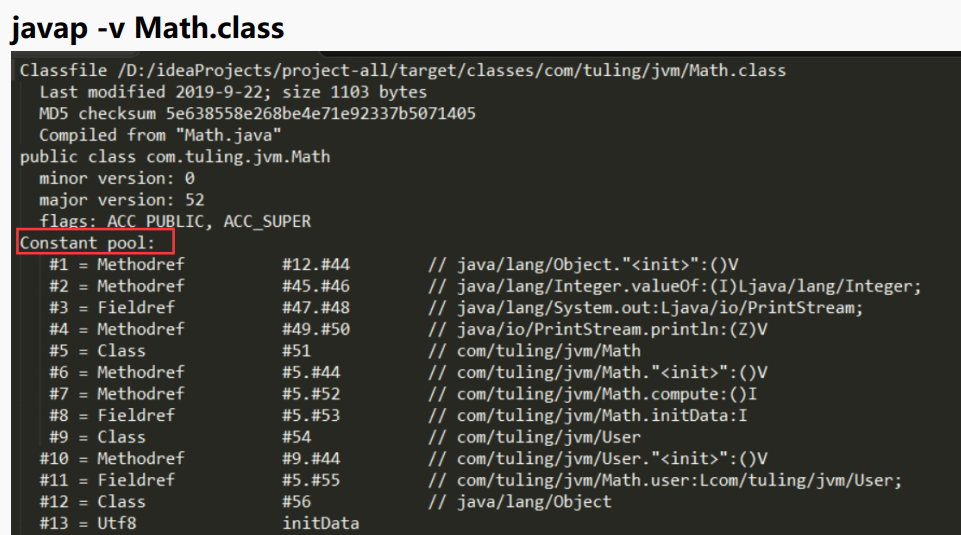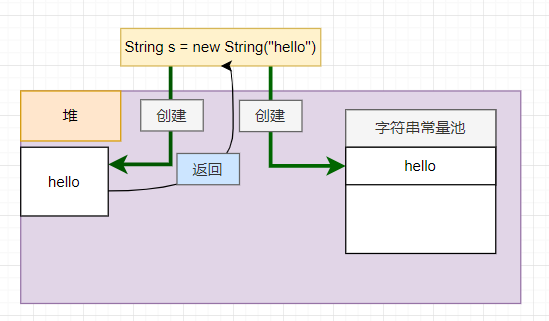代码中也没有明确的helloWorld 字面量, 为什么 s == s1 呢, 因为 hello 和 World 都是不可变的字面量,而不是一个引用,在 String s = "hello" + "World" 时, 编译器可以优化成 s = "helloWorld" , 所以 s == s1 ,那为什么 String s = new String("hello") + new String("World") 不会被编译器优化呢? 因为 new String("hello") 是一个对象,返回的是引用,而不是一个不会变化的字面量,后面这个引用地址可能会指向其他的对象,优化后可能会出现错误。同理:
Class常量池
Class常量池可以理解为class文件中的资源仓库,class 文件中除了包含类信息,方法,字段,接口信息之外还有常量池信息,用于存放编译期生成的各种字面量和符号引用。
如下:
常量池主要包含两大类常量: 字面量和符号引用。
字面量
字面量就是有字符串和数字等构成的常量。
字面量只能以右值出现,int a = 1, a 是左值,1 是右值
1 2 "abc" 都是常量
符号引用
符号引用是编译原理中概念,是相对于直接引用来说的,主要包括一三类常量:
上面的 a b就是字段名 ,是符号引用。 还有包名+类名 组成的类的全限定名,方法名,以及() 都是符号引用
运行常量池
存在class 文件的常量都是静态信息,只有到运行时被加载到内存中,这些符号才有具体的内存地址,这些常量一旦被加载内存中,就变成运行常量池,对应的符号引用在程序运行时,会被加载到内存区域的代码直接引用,也就我们说的动态链接,例如: compute() 这个符号引用在运行时就会被转化成compute()方法具体代码在内存中的地址,
字符串常量池
在内存中专门存放字符串字面量的区域称作字符串常量池,那么除了把对象放入堆中之外。还需要独立的区域存放字符串字面量呢?
主要是为了性能:
JVM 为了提高性能和减少内存开销,在实例化字符串常量的时候进行了一些优化:
什么时候会把字符串常量放入常量池
这种方式创建的字符串只会在常量池中,不会在堆中额外创建一个对象
当再次创建字符串
String s1 = "hello"时,先去常量池中通过equals(key)方法判断是否有相同的对象,如果有直接返回对象在常量池的引用。如果没有会在常量池新新建对象,再返回引用所以有如下结果:
这中方式创建字符串会保证常量池中和堆中都有这个对象,最后返回堆中的地址:
String intern 方法是一个 native 方法,如果池中已经包含一个等于此 String 对象的字符串,则返回池中的字符串,否则将intern 返回的引用指向当前字符串(在 jdk 1.6 中,需要将s1字符串复制到常量池中)
在第一种情况,
String s = "hello"会将hello放入常量池中, 第二种情况String s = new String("hello")也会将hello放入常量池中,那么什么情况下常量池会没有我们要取的字符串呢?常量池存放的一定是不可变的字面量, 无论是
String s = "hello"还是String s = new String("hello")都有一个明确的字面量:hello如果是下面这种情况:常量池中有
hello和World但是没有helloWorld, 因为在代码中没有明确的helloWorld字面量,所以 s != s1, 常量池中没有helloWorld字面量,所以s.intern()返回的是堆中的地址,故而s == s.intern()再看下面一种情况:
代码中也没有明确的
helloWorld字面量, 为什么 s == s1 呢, 因为hello和World都是不可变的字面量,而不是一个引用,在String s = "hello" + "World"时, 编译器可以优化成s = "helloWorld", 所以 s == s1 ,那为什么String s = new String("hello") + new String("World")不会被编译器优化呢? 因为new String("hello")是一个对象,返回的是引用,而不是一个不会变化的字面量,后面这个引用地址可能会指向其他的对象,优化后可能会出现错误。同理:但是被 final 修饰的变量可以被优化,因为它不会发生变化了:
再看下面一种情况:
s 的值无法再编译器确定,所以无法优化成字面量
再看最后一个例子:
为什么同样的写法,结果却不一样呢?
intern() 方法优先返回常量池中的地址, 常量池不存在时,再返回堆中的地址, 第一个 s1 != s1.intern() 是符合我们直觉的,因为常量池中没有 helloWorld , 但是第二个 s == s.intern() 为false 就说不通了,难道常量池已经有
java这个字面量了吗? 是的, java 这个关键词,在jvm 启动或类加载期间肯定有java这个字符串已经放入到常量池中了, s.inern() 返回的是常量池中的地址.八种基本类型的包装类和对象池
java中基本类型的包装类的大部分都实现了常量池技术(严格来说应该叫对象池,在堆上),这些类是 Byte,Short,Integer,Long,Character,Boolean,另外两种浮点数类型的包装类则没有实现。另外 Byte,Short,Integer,Long,Character这5种整型的包装类也只是在对应值小于等于127时才可使用对象池,也即对象不负责创建和管理o大于127的这些类的对象。因为一般这种比较小的数用到的概率相对较大